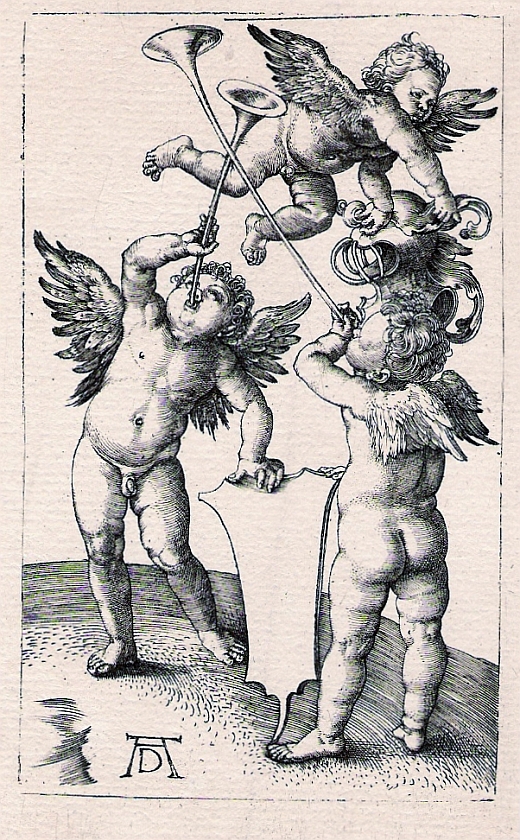
Die Nacht ist hin, nun wird es Licht,
Da Jakobs Stern die Wolken bricht.
Ihr Völker, hebt die Häupter auf
Und merkt der goldnen Zeiten Lauf!
Du süßer Zweig aus Jesses Stamm,
Mein Heil, mein Fürst, mein Schatz, mein Lamm,
Ach, schau doch hier mit Freuden her,
Wie mein Herz die Wiege wär!
Ach komm doch liebster Seelenschatz!
Der Glaube macht dir reinen Platz,
Die Liebe steckt das Feuer an,
Das auch den Stall erleuchten kann.
Ihr Töchter Salems, küßt den Sohn!
Des Höchsten Liebe brennet schon.
Kommst, küßt das Kind! Es stillt den Zorn.
Ach, nun erhebt der Herr mein Horn!
Night is passed, dawn comes,
Jacob’s star breaks through the clouds.
Peoples, raise up your heads
And note the begin of the golden times!
You sweet branch of Jesse’s trunk,
My savior, my prince, my treasure, my lamb,
Look with joy
How my heart would be the cradle!
Oh come my dearest treasure!
For you my faith makes a pure place, and
My love ignites a flame,
Which will also fill the stable with light.
You daughters of Salem, kiss the son!
The love of the Highest is already burning.
Come, kiss the child! It will stem your anger.
Now the Lord raises my horn!
—Johann Christian Günther, Weihnachtsode (1721) in: Sämtliche Werke, vol. 2, pp. 168-169 (1931)(S.H. transl.)
Listening Suggestion for Christmas Day:
I: Johann Sebastian Bach, The Christmas Oratorio, BWV 248. This is not one of Bach’s better known works–it lacks the drama and pathos of other works suitable for the Christmas season, especially the two passions. Bach cobbled this work together from a number of motets and cantatas, especially from the Advent cycle. But the composition works very effectively. And the second part, “Brich an du schönes Morgenlicht,” a chorale for choir and orchestra, composed in 1734, thematically tracks Günther’s poem very closely. Bach knew and admired Günther’s poetry, including this work.
II: Michael Praetorius, Christmette (A Christmas Mass, Lutheran rite)(1603-20). If you don’t know about the great polyphonic tradition before Bach, or think it was only some place south of the Alps, you should examine the Praetorius Christmas Mass assembled by Paul McCreesh and the Gabrieli Consort and Players on a Deutsche Grammophon/Archiv recording. The music is powerful, even transporting, and not widely heard. Praetorius is the towering figure of the period in which Reformation fades into Baroque, a man of great genius and humanity. He achieved fame across Europe not only for his sacred music, but also for his marvelous compilations of courtly dance tunes, and with his fame he also accumulated wealth that was almost unheard of for a composer of this era. When he died, in 1621, he bequeathed his entire fortune to a foundation for the relief of the poor and infirm. Praetorius wrote a series of treatises on the art of constructing and playing the organ, on composition and an almost forgotten treatise which relates music theory to theology, the Syntagma musicum. He also collected widely from the region. This recording is an attempt to reconstruct a Lutheran Christmas Mass in the form in which it would have been celebrated around 1610, drawing on compositions from Praetorius (but also Scheidt and Schütz) for the musical elements. The vocal music includes several of Praetorius’s most significant shorter works, including the hymn “Vom Himmel hoch, da komm ich her,” the sacred motet “Jesaja dem Propheten das geschah,” and the two communion motets “Wie schön leuchtet der Morgenstern” and “Uns ist ein Kindlein heut geborn.” The recessional is arguably the most important early Baroque work associated with the celebration of Christmas, “In dulci jubilo.” The mass runs eighty minutes. This music extends the bounds of time itself, and listening to it nourishes, inspires and moves anyone who truly listens forward on an important inward journey. Eighty minutes: but a glimmer in time.



